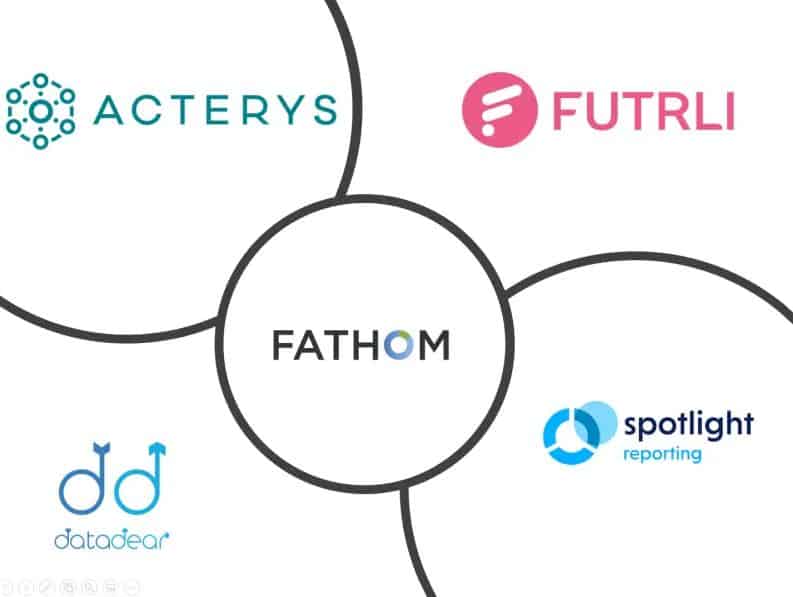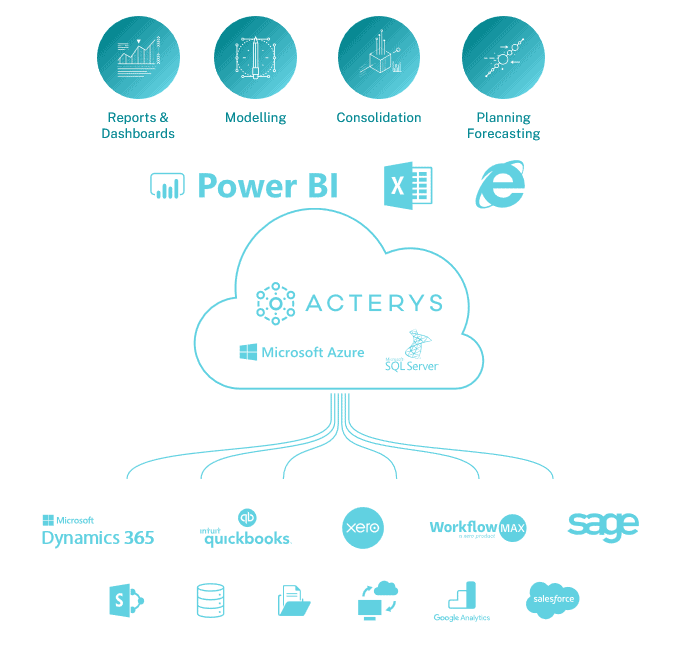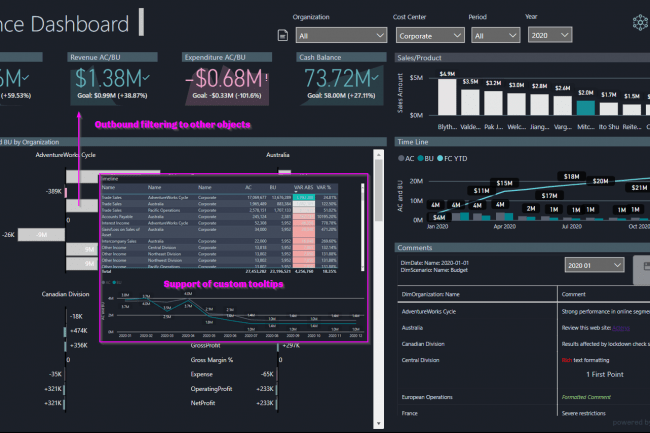
Table of Contents
With cloud based accounting systems like Xero, QuickBooks and MYOB data analysis and reporting is typically limited for that reason a variety of add-ons like Spotlight, Datadear and Futrli are available to make up for the limited options in the software itself. This becomes even more pressing when you need to combine the data in these systems with other data sources.
“Off The Shelf” Web Services
For requirements where users are looking for exactly what the web application offers, they can be a good choice. Particularly, when only better reporting and simple planning with summary accounting data are the key objectives and the required process matches the one offered in the app. What typically lacks in that context is flexibility and options for customization. As more or less closed web services are hard to adapt beyond the functionality they provide out of the box.

Acterys Extensible Architecture That Integrates Power BI, Excel and other frontends
As opposed to a closed, standard web application Acterys utilizes a standard database approach where all data from the source system (Xero, QuickBooks, Myob, HubSpot etc.) is loaded into the data warehouse from which the data can be accessed with the front end tool of choice: Web browser, Excel, Power BI, Tableau, etc.
The key benefits of this approach are:
Open: the standard database approach ensures you can access the data with nearly any tool and are not at the mercy of a single software vendor.
Scalability: the amounts of data and processing power can be infinitely increased to meet your needs. This includes number of companies added, users, data volumes and processing power.
Flexibility: the data model can be adapted and extended as needed. From their own mappings to adding other data sources as needed.
Backup: user have a full backup of all their data in the linked SaaS service. This helps in cases of emergency when the main system is not available but also when migrating their system onto another platform
Following we are comparing in detail, how the full data warehouse approach” differs from off the shelf web services in the analytics & planning space cloud-based accounting alongside applications like QuickBooks, Xero, MYOB and others.
[ctabutton title=”Acterys Accounting Template” content=”Try this template to profit from end-to-end analytics and planning solutions with 1-click integrations to major accounting, ERP, CRM, and other systems.” button=”Try Template” url=”https://acterys.com/acterys-pty-ltd-financial-reporting-budgeting-for-cloud-based-accounting/”]
Scalability and Large Number of Entities
Web applications are by nature limited when it comes to scale. As soon as there are multiple companies involved, data volumes get higher (at Acterys we have customers with 1.7m(!) journals per month) or data from other sources e.g. from CRM systems, marketing data (e.g. Google Analytics) and other web applications need to be integrated the web app approach reaches to its limits
Customization of typically closed off applications -without an API or an externally accessible data storage approach- is more often than not impossible.
Security
Reporting web applications typically don’t offer control over your data. Users have to accept whatever storage type and location they offer (apart from download options into Excel which many offer) and typically don’t have access to the data, apart from through the web application itself. In contrast Acterys is using the market leading Azure cloud platform with the option for customers to completely “own their data”. They can control own their “own” tenant, can exactly decide where data is hosted e.g. in a data center in their country. Peace of mind is provided through likely the most advanced security mechanisms like multi-factor authentication (MFA), IP whitelisting (only users with specifically allowed IP addresses can access data), etc.
Data Model Orientated Approach
An “open data model” orientated approach typically addresses the challenges. Here data is loaded from ERP, accounting and other systems in a separate “data warehouse” that is optimized for analytics. This is typically done in a star schema where transaction tables (e.g. GL transactions, invoices, etc.) are combined with shared dimensions (e.g. calendar, products, customers, accounts, etc.).
This enables users to define the meta data once, for example how time periods or accounts should be organized and mapped and the resulting definitions and hierarchies can then be used with all transaction tables. The benefit of this approach is, that the user is not at the mercy of a vendor. A relational database e.g. Microsoft SQL Server can be used with nearly any client tool (Excel, Power BI, Qlik, etc., etc.) and also offers the opportunity to integrate the data into custom apps (e.g. with PowerApps and Microsoft Flow)
Analysis Power
The open data model approach empower users to use the analytics solution of their choice and not be at the mercy of a particular vendor. The Acterys Power BI integration for example enables users to profit from -the at the moment most powerful analytics solution in the world- that is part of the unparalleled Microsoft ecosystem. This means you have everything from interactive dashboards, natural language query, advanced machine learning at your finger tips. Not to mention the seamless integration into Office productivity solution and new no-code workflows and app development options like Microsoft Flow and PowerApps.

What Are The Benefits?
In summary, the benefits of an open (i.e. editable by users not in a proprietary format in a closed web app) data model architecture are:
- Much improved performance and scalability as enterprise-ready platforms (e.g. Microsoft Azure) are used, with optimal data storage for analysis and simulation
- Unparalleled security options
- No limitations on the volume queried due to API call limits per day
- Data structures can be edited as required
- No limitation on adding other data sources (CRM, POS, Marketing, Inventory, etc. etc.)
- Flexible client options (e.g. data discovery tools like Power BI, Tableau, Qlik or Excel) not limited to one web application
- Planning & Workflows exactly configurable to requirements
Admittedly, this approach is not for everyone: Users will have to know how in the required tools (Power BI, Excel, data modelling) or require external expertise to set things up that divert from the standard or involve integration of other data sources.
In the following table, we have outlined the main players in SMB analytics and planning add-on solutions for cloud-based accounting and their architecture. We are admittedly not unbiased, should any of the information below need additions or be factually incorrect please let us know and we will revise.
[ctabutton title=”Want to See How Planning at Hyper Speed Feels Like?” content=”Take Acterys Power BI out for a test drive now!” button=”Start Free Trial” url=”https://acterys.com/start-your-trial/”]
How Spotlight, Futrli, Fathom and Datadear compare to Acterys
| Category | Feature | Acterys | DataDear | Fathom | Futrli | Spotlight |
|---|---|---|---|---|---|---|
| Platform | ||||||
| Platform | Web |  |
 |
 |
 |
|
| Platform | Live Excel Integration (Read Write) |  |
 |
|||
| Platform | Mobile |  |
||||
| Platform | Data Discovery Support (Read Write) |  |
||||
| Platform | Power BI |  |
||||
| Platform | Tableau |  |
||||
| Platform | Qlik |  |
||||
| Platform | Any SQL Client |  |
||||
| Reporting | ||||||
| Reporting | Reporting Options: | |||||
| Reporting | Power BI Sample Best Practice Financial Templates | Excel (client only) | Proprietary web | Proprietary web | Proprietary web | |
| Reporting | Live (read/write) Integration with Excel | |||||
| Reporting | Any client tool that can access SQL | |||||
| Reporting | Visualisation options | 200+ via Power BI | Excel | Limited | Limited | Limited |
| Reporting | Option to add custom visualisations |  |
||||
| Reporting | Pdf Report distribution |  |
||||
| Planning | ||||||
| Planning | Top Down Bottom Up Data Entry |  |
||||
| Planning | Copying of Scenarios |  |
 |
|||
| Planning | Configurable 3 Way Financial Logic (Profit & Loss, Balance Sheet, Cash Flow) |  |
 |
 |
||
| Planning | Audit Trail |  |
 |
|||
| Consolidation | ||||||
| Consolidation | Management Consolidation |  |
 |
 |
 |
 |
| Consolidation | Inter Company Elimination |  |
 |
|||
| Consolidation | FX Conversion |  |
 |
 |
 |
|
| Consolidation | Minority Interests |  |
||||
| Modelling | ||||||
| Modelling | Create Own Multidimensional Models |  |
||||
| Modelling | Editing of model dimensions e.g. mappings |  |
||||
| Calculation Language | Dax, SQL, Excel | Excel (client only) | Proprietary | Proprietary | Proprietary | |
| Advanced Analytics/AI | ||||||
| Advanced Analytics/AI | Full support for major AI engines (Azure ML, Power BI AI features, Python, r) |  |
||||
| Benchmarking | ||||||
| Benchmarking | Intercompany Benchmarking |  |
 |
 |
 |
 |
| Benchmarking | Industry Benchmarking e.g. SEC, NASDAQ |  (via Finviews option) |
||||
| Collaboration | ||||||
| Collaboration | Commenting | Flexible filter driven | Report driven | Report driven | ||
| Collaboration | Integration with MS Teams |  |
||||
| Workflow | ||||||
| Workflow | Support for MS Flow |  |
||||
| Backend | ||||||
| Backend | Data Storage | Openly Accessible Enterprise Scale Standard Database (Azure SQL/SQL Server) | Excel (client only) | Proprietary | Proprietary | |
| Backend | Own Tenant/On Premise |  |
||||
| Backend | Data Centre Location Choice |  |
||||
| Backend | API to integrate in own applications |  |
||||
| Data Integration | ||||||
| Data Integration | One Click Accounting System Connectors for | |||||
| Data Integration | Xero |  |
 |
 |
 |
|
| Data Integration | QuickBooks |  |
 |
 |
||
| Data Integration | ABC Financials |  |
||||
| Data Integration | Integration of other ERP (SAP, Oracle, Workday, Sage, etc.) via custom Connector |  |
||||
| Data Integration | Power Query Support |  |
||||
| Data Integration | Works with 200+ Connectors via Power BI (Google Analytics, Salesforce, Facebook, etc. etc.) |  |
||||
| Special Features | ||||||
| Special Features | Manual Journal Automation |  |
 |
|||
| Security | ||||||
| Security | Access | Cell based read & write | Per company | Per account | ||
| Security | Support of Security Standards | Active Directory, Windows Authentication, Microsoft Accounts | Proprietary | Proprietary | Proprietary | |
| Pricing | Starts at pricing per company per month (USD) | $29 (Package of 10) $49 (single company) |
$20 (4 companies) | $29 | $49 | $25 |
[ctabutton title=”Need Tailored Reporting, Planning & Analytics Solutions?” content=”Talk to our solution experts now” button=”Book a Meeting” url=”https://acterys.com/book-a-meeting/”]
Key Takeaways
- Accounting systems like Xero, QuickBooks, and MYOB often have limitations in data analysis and reporting capabilities. To overcome these limitations, users rely on add-ons like Spotlight, Futrli, and Datadear.
- Web applications, such as these add-ons, are suitable when users require exactly what the application offers, especially for better reporting and simple planning with summary accounting data.
- Acterys takes a different approach by using a standard database to load data from source systems like Xero, QuickBooks, and Myob into a data warehouse.
- Users can access the data using various front-end tools such as web browsers, Excel, Power BI, Tableau, and more.
- The Acterys approach allows users to access their data with nearly any tool, and there are no limitations on data volume or integration with other data sources.
- Acterys’ data model-oriented architecture outperforms off-the-shelf web services in terms of scalability, customization, security, and flexibility.
FAQs
1. Why do cloud-based accounting systems like Xero, QuickBooks, and MYOB have limitations in data analysis and reporting?
Cloud-based accounting systems are primarily designed for core accounting functions. While they excel at transaction processing, they often lack advanced data analysis and reporting features. This limitation becomes evident when users need to combine data from these systems with other data sources for comprehensive analysis.
2. What are “Off The Shelf” web services, and when should they be considered?
“Off The Shelf” web services are third-party add-ons like Spotlight, Datadear, and Futrli that extend the functionality of cloud-based accounting systems. They are suitable when users require better reporting and simple planning with summary accounting data, and the provided features align with their needs. However, these services may lack flexibility and customization options.
3. How does Acterys differ from standard web applications in data analysis and reporting?
Acterys takes an open and extensible approach by utilizing a standard database architecture. It loads data from source systems like Xero, QuickBooks, and Myob into a data warehouse, allowing users to access the data using various front-end tools such as web browsers, Excel, Power BI, Tableau, and more. This approach offers greater flexibility, scalability, and data control compared to closed web applications.
4. What are the key benefits of Acterys’ data model-oriented approach?
Acterys’ data model-oriented approach offers several benefits, including:
- Openness: Users can access data with nearly any tool, avoiding vendor lock-in.
- Scalability: It can handle large amounts of data and processing power, accommodating growing needs.
- Flexibility: Users can adapt and extend the data model as required, including adding other data sources.
- Backup: Users have a full backup of their data, providing security and flexibility in case of emergencies or system migrations.





